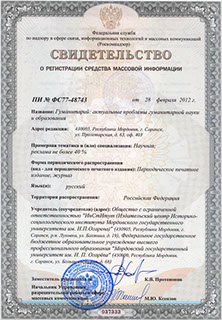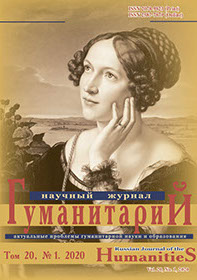ГуманитариЙ актуальные проблемы гуманитарной науки и образования
Russian Journal of the Humanities
ISSN 2078-9823 (Print)
ISSN 2587-7879 (Online)
Navigation
ISSN 2078-9823 (Print), ISSN 2587-7879 (Online)
DOI: 10.15507/2078-9823.049.020.202001.009-017
Sergey V. Pershin1, Tatyana A. Pershina2
1 Research Institute of the Humanities under the Government of the Republic of Mordovia (Saransk, Russia),
e-mail: Pers99@inbox.ru
2 National Research Ogarev Mordovia State University (Saransk, Russia),
e-mail: 730791@bk.ru
Historiography of the problem of transformation of the family structure of Finno-Ugric peoples
Introduction. The priority direction of the study of Finno-Ugric peoples is to determine the forms of family, the most characteristic for different stages of historical development. The article presents the results of studying the historiography of the problem of transformation of the family structure of the Finno-Ugric peoples. Materials and Methods. The theoretical and methodological basis of the study is a systematic approach, the implementation of which provides a comprehensive analysis of the family structure. The solution of research problems was provided by complementary theoretical (analysis of scientific and methodological literature on the studied problem, comparative analysis, comparison, generalization, systematization) and empirical (study and generalization of scientific literature) methods. Result. Since the second half of the XX century the structural elements of the family have repeatedly become the object of research by scientists (historians, demographers, ethnologists and sociologists). Due to the introduction of mass sources into scientific circulation, scientists have identified the dominant types of kinship relations, population, marriage and generational composition of the majority of Finno-Ugric peoples. Separate scientific schools managed to achieve more: on the basis of allocation of the general and special, to establish the basic regularities of transformation of structural elements, to estimate degree of influence of structurally forming factors at different stages of historical development. Discussion and Conclusion. The main conclusions are presented in the article create a theoretical and methodological basis for further study of the family composition of the Finno-Ugric peoples. As a priority task for scientists representing different research areas, but united by a common purpose to study structural elements of the Finno-Ugric family, are: 1) unification of methods of processing data related to family composition; 2) project implementation methodology; 3) conduct comparative studies on the family of Finno-Ugric peoples.
Keywords: family, family typology, number, marriage, generational composition, Finno-Ugric peoples, family structure, historiography.
For citation: Pershin S. V., Pershina T. A. Historiography of the problem of transformation of the family structure of Finno-Ugric peoples. Gumanitarian : aktual’nye problemy gumanitarnoi nauki i obrazovaniia = Russian Journal of the Humanities. 2020; 20(1): 9–17 (In Russ.). DOI: 10.15507/2078-9823.049.020.202001.009-017.
Acknowledgements: This work was supported by the Russian Foundation for Basic Research, project
no. 18-49-130002.

© Ogarev Mordovia State University. History and Sociology Institute, 2017
68, Of. 411, Bolshevistskaya St., 430005, The editorial office of the scholarly journal «Russian Journal of the Humanities»
Tel.: (8342) 24-25-90; 27-07-11, Fax: (8342) 24-25-90, E-mail: jurnal-econom-hist@isi.mrsu.ru
Designed by A. Napalkov, Email: napalkov@isi.mrsu.ru

